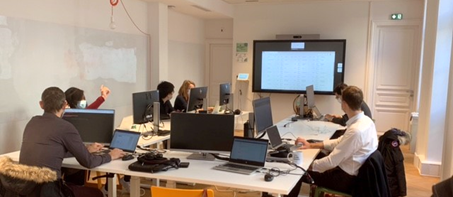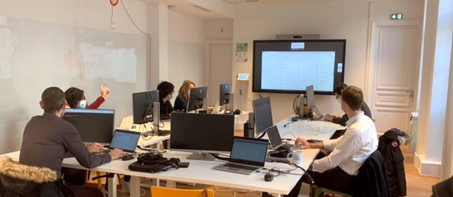BNP Paribas Cardif: Innovating in a Changing World
Sebastien Conort, Chief Data Scientist, BNP Paribas Cardif, Sandrine Aymes, Analytics Transformation, BNP Paribas Cardif2022-05-19 | 7 min read

We all face it: the need to do more, faster.
As a major player in the insurance industry, BNP Paribas Cardif wants to accelerate every customer interaction—from issuing policies and processing claims to understanding their feedback—if we are to meet changing customer expectations. We need to accelerate the delivery of new product offerings to protect our customers during changing times. And we need to do it all while rapidly identifying and managing risk and regulatory compliance. For our data science team, it requires that we increase our model velocity to accelerate every part of our work, from model research and development to deployment and continuously improving those models.

Data science hackathons, or data challenges, have long been considered a tool for inspiring creativity and collaboration. Here at BNP Paribas Cardif, we conduct both internal and group-wide data challenges with employees. Our colleagues in Latin America have even conducted their first-ever external virtual data challenge last year with 100 data scientists from universities and partner companies across Chile, Colombia, Mexico, and Peru.
For our most recent data challenge, we hosted an ambitious group-wide data challenge that brought together 70 data scientists from across BNP Paribas Group over three days, working in teams to solve a complex business challenge.
This data challenge wasco-organized with the BNP Paribas Retail Banking & Services Data & Analytics team for the challenge design, and NiCKEL for the data and the business case.With over 6,500 outlets, NiCKEL is the second-largest distribution network for accounts in France, servicing two and a half million clients. As a business challenge, they asked teams to analyze verbatim text transcripts of real-world customers using advanced natural language processing (NLP) techniques in order to pinpoint topics, sentiments, and factors driving each customer’s experience. We were glad to propose our technical and technological expertise to host the challenge. Our setup based on the Domino platform allowed us to provide each team with a graphics processing unit (GPU) which enabled the data scientists to explore state-of-the-art target-based sentiment analytics models requiring this level of powerful compute resources.
Three days isn’t a lot of time to complete such a challenge. Having to innovate in this short time during the hackathon offers several essential reminders for how to manage data science projects to innovate faster in our daily work.
Simplicity Outperforms Complexity
Complex challenges like this one often require complex solutions. And in data science, our inclination may be to dig in, mapping from the start all the ideas of features and functions that should enable us to predict the most accurate answer. However, the winning team generated the best results by building their solution step-by-step, starting with a few key features, visualizing this early work on a dashboard, and then upgrading it bit-by-bit. Those teams that began with a more complex solution often struggled to implement it.
Teamwork Must Go Beyond Individual Teams
BNP Paribas Group is a distributed organization with more than a dozen business entities organized within three main fields of operation — Commercial and Personal Banking and Services; Investment and Protection Services; and Corporate Institutional Banking. Representatives from different entities across BNP Paribas participated in the data challenge, many of whom hadn’t previously met. Over the three-day competition, teams could collaborate on code using the Domino platform and quickly built on each other’s ideas to push the limits of what was possible. In our day-to-day work here at BNP Paribas Cardif, our 100 data scientists use Domino daily to share their work so we’re not always starting from scratch. Such cooperation also strengthens our data science community, creates career mobility opportunities for data scientists, and fosters staff retention.
Rapid Innovation Requires Rapid Iteration
For teams to test many different theories, they must be able to quickly and easily scale up the compute resources they need. This was one of the reasons my team and our IT colleagues were asked to support the challenge. Within BNP Paribas Cardif, we use the Domino Enterprise MLOps platform as our workbench. It enables our data scientists to spin up the tooling and compute they need with just a few clicks so they can iterate on more ideas faster and build, deploy and retrain models in less time. This has helped us more rapidly make progress in becoming more AI-driven. Today, we have hundreds of projects running on Domino – from first exploration to industrial development and production. For the data challenge, we worked with our IT department to make 40 GPUs available, one per team. Using the Domino platform, participants could easily access the GPUs to test their ideas. The use of high-performance compute has been core to our strategy, enabling us to take advantage of advanced AI techniques, such as state-of-the-art natural language processing.
Full Speed Ahead
We’re already planning our next data challenge, which will be as ambitious as this last one, so our experts can continue to boost their skills in advanced data science. For this upcoming challenge, BNP Paribas Cardif will provide both the platform (using Domino to serve up access to GPUs) and the business challenge, related to our second-hand mobile phone theft and damage insurance. This insurance offering aims to extend the device life cycle and have a positive impact on the environment. We will ask participants to assess pictures of used smartphone screens, using state-of-the-art computer vision techniques. Following this challenge, we may propose new services to improve the subscription and claims processes. It’s one of the many use cases on our roadmap.
We all face the need to do more, faster. Pursuing such ambitious data challenges helps us take stock of where we are as a group and reminds us of what we’re already capable of.
Learn More
- Visit the BNP Paribas Cardif website and see how BNP is making insurance more accessible.
- Read The Forrester Report, “The Total Economic Impact of the Domino Enterprise MLOps Platform,” to learn more about the value Domino delivers.


